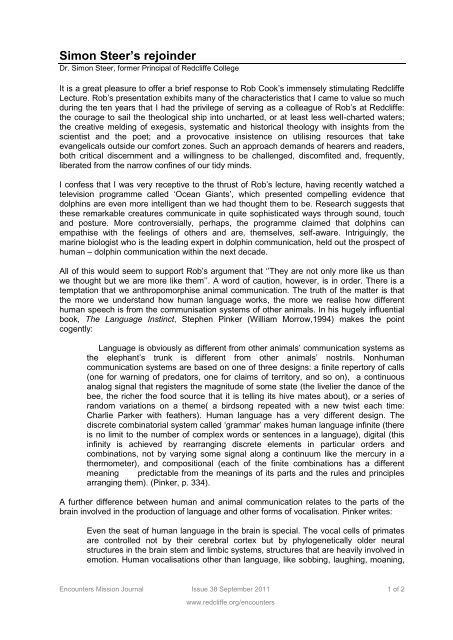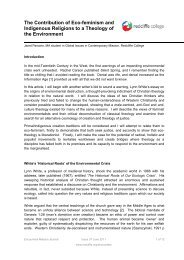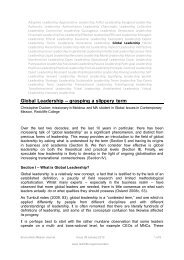Article 8 - Redcliffe College
Article 8 - Redcliffe College
Article 8 - Redcliffe College
You also want an ePaper? Increase the reach of your titles
YUMPU automatically turns print PDFs into web optimized ePapers that Google loves.
Simon Steer’s rejoinder<br />
Dr. Simon Steer, former Principal of <strong>Redcliffe</strong> <strong>College</strong><br />
It is a great pleasure to offer a brief response to Rob Cook’s immensely stimulating <strong>Redcliffe</strong><br />
Lecture. Rob’s presentation exhibits many of the characteristics that I came to value so much<br />
during the ten years that I had the privilege of serving as a colleague of Rob’s at <strong>Redcliffe</strong>:<br />
the courage to sail the theological ship into uncharted, or at least less well-charted waters;<br />
the creative melding of exegesis, systematic and historical theology with insights from the<br />
scientist and the poet; and a provocative insistence on utilising resources that take<br />
evangelicals outside our comfort zones. Such an approach demands of hearers and readers,<br />
both critical discernment and a willingness to be challenged, discomfited and, frequently,<br />
liberated from the narrow confines of our tidy minds.<br />
I confess that I was very receptive to the thrust of Rob’s lecture, having recently watched a<br />
television programme called ‘Ocean Giants’, which presented compelling evidence that<br />
dolphins are even more intelligent than we had thought them to be. Research suggests that<br />
these remarkable creatures communicate in quite sophisticated ways through sound, touch<br />
and posture. More controversially, perhaps, the programme claimed that dolphins can<br />
empathise with the feelings of others and are, themselves, self-aware. Intriguingly, the<br />
marine biologist who is the leading expert in dolphin communication, held out the prospect of<br />
human – dolphin communication within the next decade.<br />
All of this would seem to support Rob’s argument that ‘’They are not only more like us than<br />
we thought but we are more like them’’. A word of caution, however, is in order. There is a<br />
temptation that we anthropomorphise animal communication. The truth of the matter is that<br />
the more we understand how human language works, the more we realise how different<br />
human speech is from the communisation systems of other animals. In his hugely influential<br />
book, The Language Instinct, Stephen Pinker (William Morrow,1994) makes the point<br />
cogently:<br />
Language is obviously as different from other animals’ communication systems as<br />
the elephant’s trunk is different from other animals’ nostrils. Nonhuman<br />
communication systems are based on one of three designs: a finite repertory of calls<br />
(one for warning of predators, one for claims of territory, and so on), a continuous<br />
analog signal that registers the magnitude of some state (the livelier the dance of the<br />
bee, the richer the food source that it is telling its hive mates about), or a series of<br />
random variations on a theme( a birdsong repeated with a new twist each time:<br />
Charlie Parker with feathers). Human language has a very different design. The<br />
discrete combinatorial system called ‘grammar’ makes human language infinite (there<br />
is no limit to the number of complex words or sentences in a language), digital (this<br />
infinity is achieved by rearranging discrete elements in particular orders and<br />
combinations, not by varying some signal along a continuum like the mercury in a<br />
thermometer), and compositional (each of the finite combinations has a different<br />
meaning predictable from the meanings of its parts and the rules and principles<br />
arranging them). (Pinker, p. 334).<br />
A further difference between human and animal communication relates to the parts of the<br />
brain involved in the production of language and other forms of vocalisation. Pinker writes:<br />
Even the seat of human language in the brain is special. The vocal cells of primates<br />
are controlled not by their cerebral cortex but by phylogenetically older neural<br />
structures in the brain stem and limbic systems, structures that are heavily involved in<br />
emotion. Human vocalisations other than language, like sobbing, laughing, moaning,<br />
Encounters Mission Journal Issue 38 September 2011 1 of 2<br />
www.redcliffe.org/encounters
and shouting in pain, are also controlled subcortically… Genuine language… is<br />
seated in the cerebral cortex, primarily in the left perisylvian region. ( Pinker, p334).<br />
These important differences should warn us against romantic notions of animal-human<br />
proximity. The uniqueness of human beings, created in the divine image, is enhanced rather<br />
than reduced the more we understand about language. This is all the more important, given<br />
the crucial role played by what Pinker calls ‘genuine language’ in our relationship with God<br />
and in the task of mission.<br />
I was disappointed that the scope of the lecture did not allow Rob to address the practical,<br />
ethical implications of his theological tour de force. The last section of the paper, merely<br />
listing a number of contemporary challenges of great significance for animals, humans and<br />
the planet that we share, was inevitably anticlimactic. I found this particularly regrettable<br />
given Rob’s own determination to ask ‘So what?’ of any theological exercise, a determination<br />
I have witnessed countless times in lecture room, staffroom and around the meal table. I<br />
recall that the <strong>Redcliffe</strong> Lectures in World Christianity, as they were originally conceived back<br />
in 1999, were a pair of lectures rather than a single presentation. This longer format was<br />
designed to allow the lecturer to develop a thesis and then to apply it to contemporary global<br />
concerns. Perhaps Rob, in his usual modesty, will feel that the task of application is better<br />
left to others but I, for one, would have welcomed his theologically-refracted take on at least<br />
some of the ethical issues he lists. Perhaps this issue of Encounters will begin to fill this gap,<br />
not least by providing suggestions for further reading.<br />
My only other reservation about an otherwise excellent lecture is that it doesn’t address<br />
enough explicitly missiological questions. As I know that Rob is deeply interested in such<br />
questions, this absence may again be caused by the restrictions of space. In my own article<br />
on ‘Ecology/ Environment’ in the Dictionary of Mission Theology (John Corrie, ed.: IVP,<br />
2007), I suggested that we may need to repent of an excessively anthropocentric theory and<br />
practice of mission. A properly biblical understanding of mission embraces the whole of<br />
creation within its remit. That is one reason why I was so delighted by Rob’s choice of topic<br />
for the annual <strong>Redcliffe</strong> Lecture. Given <strong>Redcliffe</strong>’s reputation for outstanding mission training<br />
and rigorous, biblically faithful and yet innovative missiological thinking, it is entirely<br />
appropriate that the <strong>College</strong>’s Head of Theology for the past 20 years should choose to<br />
address such a topic in this, the year of his retirement. I wonder, however, if Rob might have<br />
adopted a more missiological point of view. What changes to individual and organisational<br />
mission strategies would we expect to see if animals were given the attention that Rob’s<br />
lecture so persuasively implies?<br />
These reservations aside, Rob has done us a great service in bringing his great intellectual<br />
gifts to bear on such an interesting and important topic. I am quite sure that creaturely<br />
theology will be something of a growth industry in the years to come and the enterprise will<br />
be greatly enriched if Rob continues to do creative meditations with his cat.<br />
Please Note: The views expressed in this article are those of the author and do not necessarily reflect the position<br />
of <strong>Redcliffe</strong> <strong>College</strong>.<br />
This and other articles can be downloaded from the Encounters website (www.redcliffe.org/encounters).<br />
Encounters Mission Journal Issue 38 September 2011 2 of 2<br />
www.redcliffe.org/encounters




